Fertilizer Numbers: What N-P-K Numbers Mean
Author: Chris Miller | Editor: Omar Alonso
Review & Research: Jen Worst & Chris Miller
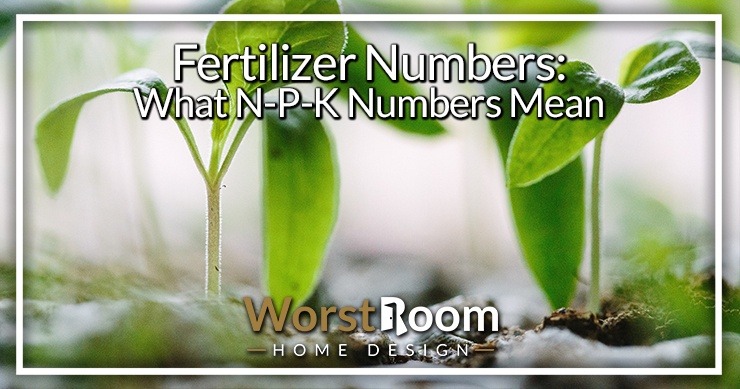
Every gardener likely remembers having to ask the question of what the heck these fertilizer numbers are on the front of the bags. We can usually figure things out, but there are zero clues to helping us decipher these labels without a little help.
I'm going to explain these fertilizer labels up front for those looking for a quick answer, and then we'll dive into more topics surrounding them. Because if you're like me, you want to cover the whole topic, learn it, and not have to return to it again.
What Do the Numbers on Fertilizer Mean?
On the front of fertilizer bags you'll find three bold numbers, called N-P-K numbers. These represent the three primary nutrients in fertilizer: nitrogen (N), phosphorous (P), and potassium (K). These exist to help you quickly compare products.
Don't mistake these labels for the chemical compounds. Their molecular formulas are actually N for nitrogen, P2O5 for phosphate, K2O for potash (which contains K for potassium).
So to read these numbers, take for example a fertilizer mixture labeled as 0-20-20. This means the mixture contains 0% nitrogen, 20% phosphorous, and 20% potash. The remaining 60% is called "filler," which is usually sand, granular limestone, or a blend of other substrate materials.
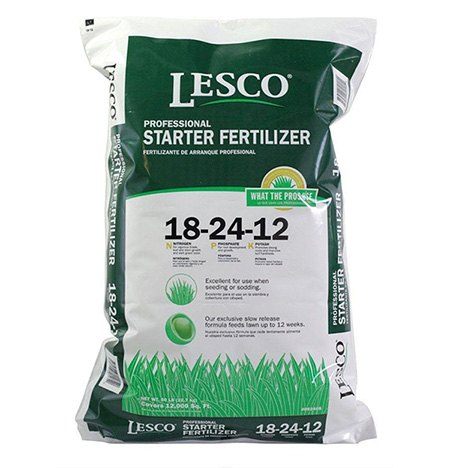
Let's use the image above as another example. This fertilizer is 18% nitrogen, 24% phosphorous, 12% potash, and 46% filler.
These fertilizer numbers are the fertilizer grade, which quickly explain to you the ratios of the three primary nutrients mixed into the blend. Various grades are available because differing types of plants thrive better with a different balance of nutrients.
Calculating Nutrient Content From Fertilizer Numbers
We now know that the 3 numbers on fertilizer bags are percentages. For example, if the first number is a 10, then that means that 10% of the total 25 pound fertilizer bag is made up of nitrogen.
If you recall from your math classes, you can divide a percentage number by 100 (by moving the decimal place to spots to the left) to represent it as a decimal instead. So 10% is the same as 0.10, just written differently so it can be used in math equations.
This allows us to take the total weight of the bag and multiply that by the percentage in decimal format to find out exactly how much of a primary nutrient is in the fertilizer mixture.
In our example, we can take 25 pounds and multiply it by 0.10 to find that our fertilizer bag contains 2.5 pound of nitrogen.
Let's run through a full example with a 50 pound bag of 6-6-18 fertilizer (remember, the order of the numbers is N-P-K):
- Nitrogen: Divide 6% by 100 to get 0.06 and multiply that by 50 pounds, which equals 3 pounds.
- Phosphorous: The number is also 6%, which ultimately equals the same 3 pounds.
- Potash: Divide 18% by 100 to get 0.18 and multiply that by 50 pounds, which equals 9 pounds.
This means a 50 pound bag of 6-6-18 fertilizer contains a total of 15 pounds of nutrients. These are 3 pounds of nitrogen, 3 pounds of phosphorous, and 9 pounds of potash. The remaining 35 pounds is made up of filler material.
Why These 3 Fertilizer Numbers & Not Others?
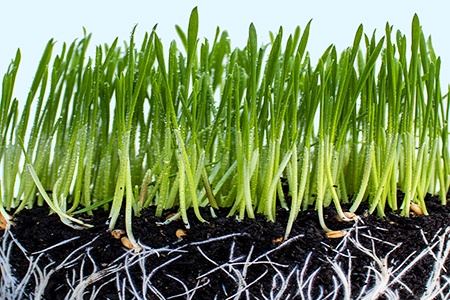
Though there are 17 nutrients that are critical to supporting all plant life, nitrogen, phosphorous, and potassium are the three primary macronutrients that they need more than all others.
There are others, like iron, that are also essential to plant life but are only needed in much smaller amounts. Flowers, like the various types of azaleas, need more iron than your lawn, for instance.
This is why when you look at specialty fertilizers, they will mention the plant-specific nutrient on the front and in the ingredients list.
Because plants need these macronutrients in larger quantities, they can drain their soil of these nutrients over time, sometimes depleting them entirely. Heavy and constant raining cause nitrogen to flow out of the soil (called leaching).
Replenishing the soil with these three nutrients matters more than any others, which is why these three are the numbers on fertilizer bags.
How Do These 3 N-P-K Numbers Benefit Plants?
We know each of these 3 macronutrients are critical to plants, but how exactly? Nitrogen (N) provides the ability to grow at a normal rate with plentiful and rich green leaves.
Of course, this helps them have more chlorophyll and helps with photosythesis (absorbing light and converting it to energy).
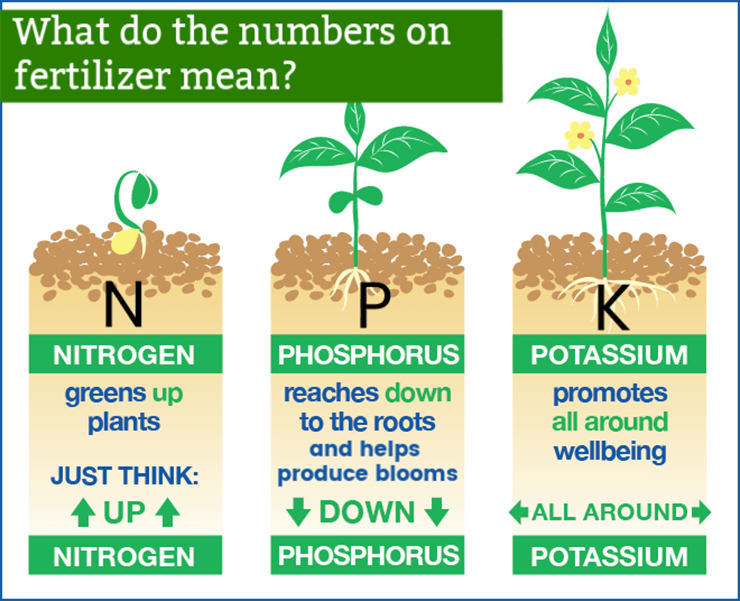
A low amount of nitrogen causes plants to slow their growth and lose their green color, resulting in yellow-green leaves (called chlorosis). Not only is it unsightly but your garden crops will produce a lesser and weaker abundance of fruit and vegetables.
Too much nitrogen causes plants to focus on their leaves with less emphasis on the flower's bloom or the food product.
Phosphorous (P) helps the plants use all other nutrients efficiently, but also guides the plants to through a strong development of their roots and blooms.
The right amount of phosphorous means you'll have beautiful flowers, healthy fruits, and potent seeds. Too much or too little will lead to a lopsided development.
Potassium (K) aids in general growth, including root and top growth. It not only boosts growth in the right amounts but regulates overgrowth where a plant can over-extend itself.
It also strengthens the cell walls, allowing for stronger stems and wind and weight resistance. It also helps with disease and pest resistance as well as from cold weather or drought conditions.
Why Is There Sometimes a 4th Fertilizer Number?
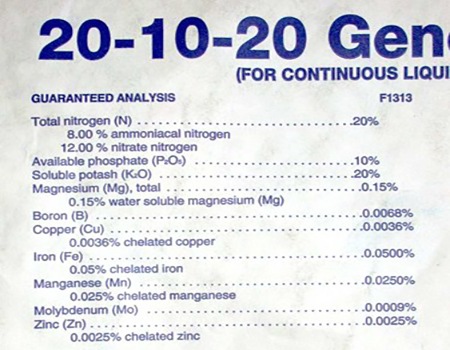
In some cases, a fertilizer blend is created for a specific type of plant. As mentioned above, azaleas need more iron than is typical. Some blends will feature a fourth number that stands for the amount of iron, in this case.
Other times they tuck that information away on the ingredients list but will mention the fourth nutrient in the product name or on the front of the fertilizer bag. It just depends on how they choose to pursue their marketing.
Brands that do choose to include the 4th number will sometimes include it on other products that don't have a specialized fourth nutrient involved, in which case the number is listed as 0, meaning there's zero percent of any extra trace minerals.
This is only to not confuse their customers who are used to seeing this 4th fertilizer number. Common 4th numbers represent nutrients like iron (Fe), calcium (Ca), magnesium (Mg), and sulfur (S).
How to Choose the Right Garden Fertilizer Numbers
It's impossible to cover every scenario but I can give a few examples and explain why the N-P-K ratios are appropriate. Your best move is to simply browse the fertilizers available from big companies. They will name special ratios for the type of plant that thrives with that ratio.
Pennington's Lilly Miller fertilizers include one called "MORCROP Tomato & Vegetable Food" that features the N-P-K numbers 5-10-10. This is because vegetables like tomatoes create a large demand of phosphorous and potassium in order to produce many large fruits.
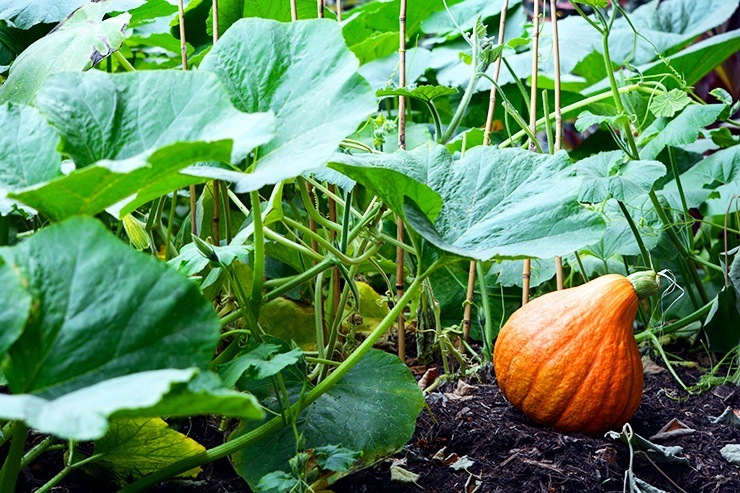
Flowers with big bulbs need a lot of phosphorous to spread their roots deep and wide, but they also need nitrogen to create beautiful flowers and leaves. That's why their "Lilly Miller Bone Meal" has the N-P-K numbers 6-12-0.
Of course, for a general purpose garden growing various types of flowers or vegetables, you can always use a balanced 10-10-10 fertilizer to help ensure every plant gets what it needs. You won't provide too much of any one nutrient this way.
But for specific uses, it's recommended to use the specialty fertilizer created for that purpose.
How to Choose the Right Lawn Fertilizer Numbers
Choosing the right fertilizer for your lawn in general is not the same as choosing one for creating a bulk amount for potted plants or gardens. With a lawn you're trying to return nutrients to soil that has been depleted over decades if not longer.
But you can't just add any amount of nutrients. You need to know how imbalanced your lawn soil currently is so you can add the right amount back so your grass and trees can thrive (versus become sickly).
The bottom line is you need to have a soil test performed by a professional. You'll take soil core samples from various areas in your yard and send them off to a laboratory, which will return a soil test report to you, guiding you on what grade of fertilizer you may need.
Of course, you could try to search for the symptoms your lawn is suffering from and see what people suggest if you don't want to do it right. And as we know, nobody just makes stuff up on the internet, right?
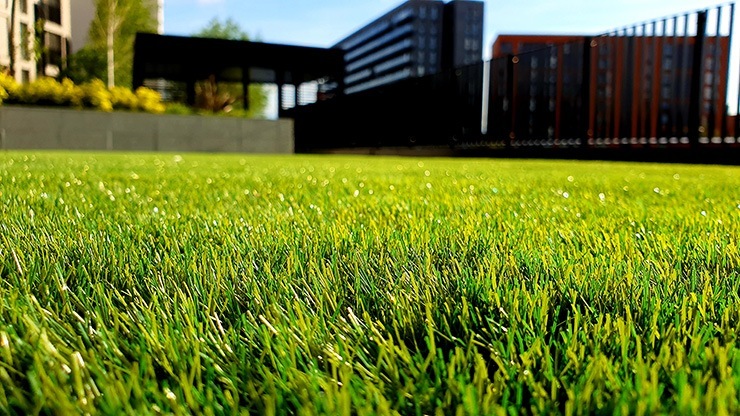
Typically, the grades you'll find recommended for the average lawn and garden are:
- 5-10-5
- 10-10-10
- 5-10-10
- 6-6-18
- 8-0-24
There are others, of course, like the interesting 0-20-20 fertilizer I've talked about. But remember, no lawn is equal and will need its own appropriate mixture.
For a currently healthy lawn, most people use a fertilizer with a higher nitrogen number to promote a greener and more vigorous growth of grass, especially since rain can deplete nitrogen.
When you spread your fertilizer, you need to make sure you're doing it right or you'll end up with strips of grass and plants with differing colors. This is almost entirely due to the fertilizer spreader you're using.
You want one that slings the mixture in a 360 degree pattern (like the one in the image above) instead of just forward as you walk with it.
A Few Words of Fertilizer Advice
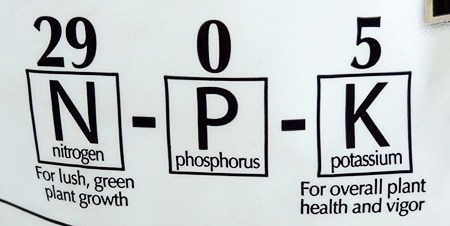
Here's a couple more things to consider before you run off looking for the right fertilizer numbers.
Organic Fertilizers Vs. Synthetic Fertilizers
One more word of advice. When using a natural, organic fertilizer you need to plan in advance as they need time to be broken down by soil microbes before the nutrients can be used by the plants.
This includes ones like blood meal, manure, crab meal, cottonseed meal, and feather meal. People prefer these over synthetic fertilizers, even though synthetics work faster, because they include less salts and acids (that can "burn" the foliage) and last longer.
Granular Fertilizers Vs. Soluble Fertilizers
When looking through both organic or synthetic options, you'll find that there are other options. Granular fertilizers are recommended if you plan in advance. They come in solid pieces that take time and water to break down.
There are also slow-release fertilizers that try to meter out the nutrients over the course of weeks so you can have less involvement after the first session of work.
There are also soluble fertilizers, sometimes called "liquid feed," that provide immediate nutrients (think Miracle-Gro, for instance). These are nice for emergency applications but don't last nearly as long per application.
And That's Fertilizer Numbers Demystified!
It's all about the N-P-K. In general, if you just want to replenish any soil without going all scientific on it, a safe option is a 5-5-5 fertilizer, or even a 10-10-10 option. They'll provide all your plants need without too much of any one nutrient. To you, I wish a great harvest!



